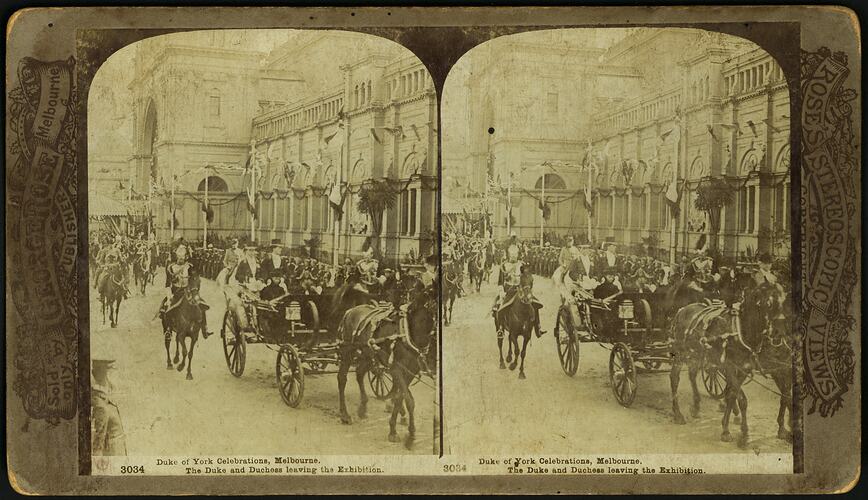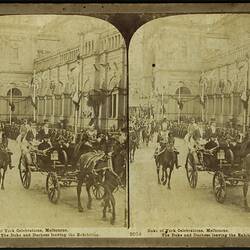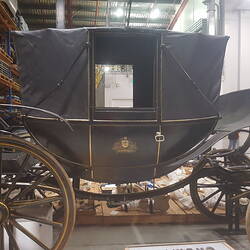Summary
The State landau was used by the Duke and Duchess of Cornwall and York, on their procession from Government House to the (Royal) Exhibition Building for the opening of the first federal parliament of Australia on 9 May 1901.
The 'State Landau' was made by Hooper and Co of Haymarket, London, in the late 1890s. Hooper and Co were one of Britain's most prominent high-class coach builders. Established in 1807 by Adams and Hooper, the firm gained its first royal warrant in 1830, with their appointment as a coach builder to King William IV and undertook work for every British Monarch since. Their long list of notable customers included British nobility and many foreign heads of state from the Emperor of Japan and Shah of Persia to Czarevich Alexander (III) of Russia. Hooper specialised in the very top end carriages with the most luxurious bodies possible for which construction cost was almost of no consideration. Ironically the firm's greatest success came during the early 20th century after they began making custom bodies for Rolls Royce and Daimler motor cars. By the mid 1930s they were operating two factories, at Chelsea and Acton, building over 300 bodies a year, but with declining demand for custom made motor bodies after the Second World War, and a shortage of skilled workers, production finally ceased in 1959.
This Hooper landau is believed to have first been used as a semi-State carriage in the Great Procession for the Diamond Jubilee of Queen Victoria in London, in 1897. It was regarded in its day as being 'severely plain and old fashioned' with 'no features of special interest'. The landau was brought to Melbourne as part of a fleet of horse-drawn vehicles for the official use of the first Governor-General of Australia, the Earl of Hopetoun, probably in 1900. It was one of four State coaches used in ceremonial processions during the visit of the Duke and Duchess of Cornwall and York (later King George V and Queen Mary) to Melbourne in May 1901, to celebrate the opening of the first Federal Parliament of Australia in the Melbourne Exhibition Buildings.
In April 1927, the carriage was used several times by the Duke and Duchess of York (later King George VI and Queen Elizabeth), during their visit to Australia. It was again used in October and November 1934, during the visit of the Duke of Gloucester (third son of King George V) for the opening of celebrations marking the Centenary of the first permanent (European) settlement in Victoria and the dedication the Melbourne Shrine of Remembrance. This was the last recorded official State duty of the landau, and is the best documented with a superb range of newspaper photographs showing in sharp detail its beautifully polished bodywork and upholstery and gleaming patent leather mudguards.
At some stage after 1934, the State Landau was donated to the Trustees of the Exhibition Building for display in the Museum associated with the Aquarium at the Exhibition Building. Fortunately the vehicle was saved from the fire that destroyed the Aquarium in January 1956 and was transferred to the State Library later the same year. In 1971 to 1973 the landau was ridden during three Melbourne Cup Carnivals by the Governor General of Australia in processions at Flemington Racecourse. In August 1973 it was lent to the Science Museum of Victoria and was later officially transferred to their collection.
The State Landau is of national significance to the cultural and political history of Australia, being one of the few surviving large artefacts with a tangible association to the celebrations surrounding the opening of Australia's first Federal Parliament in Melbourne, in May 1901, and with Royal visits both on this and two subsequent occasions.
In the pre-television and cinema age, street processions formed an important part of most public celebrations and were events of both spectacle and colour, typically including triumphal arches, bunting, banners and flags, as well as floats, horse-drawn carriages and riders in the finest livery.
It was in large mass public gatherings, such as the street parades before the opening of Federal Parliament at the Royal Exhibition Building, that most Australians of the day gained their only opportunity to glimpse royalty. Street Processions with open horse-drawn carriages created an extraordinary sense of intimacy in which thousands of Victorians would feel they could almost touch their future Monarch or cry out and be heard by the ears of Royalty. For two generations of Australians in the early 20th century, the Governor's Landau and other similar State coaches created an image that was indelibly linked to their first experience and memories of Royalty.
More Information
-
Keywords
-
Authors
-
Article types



